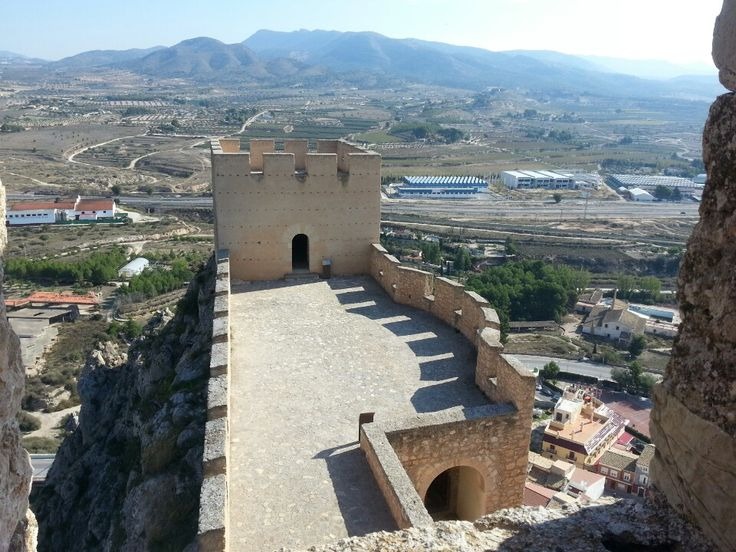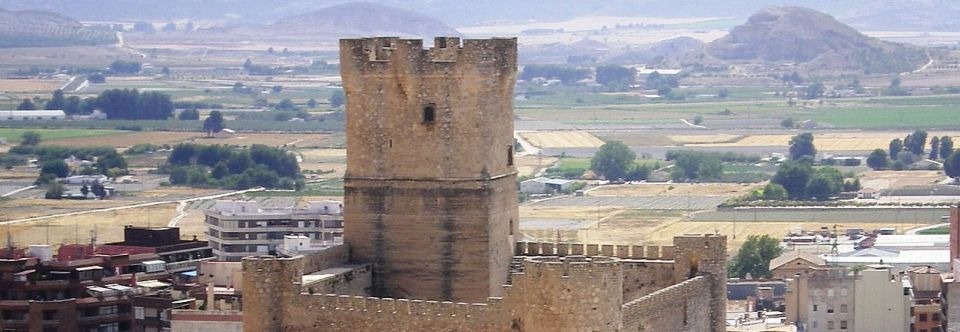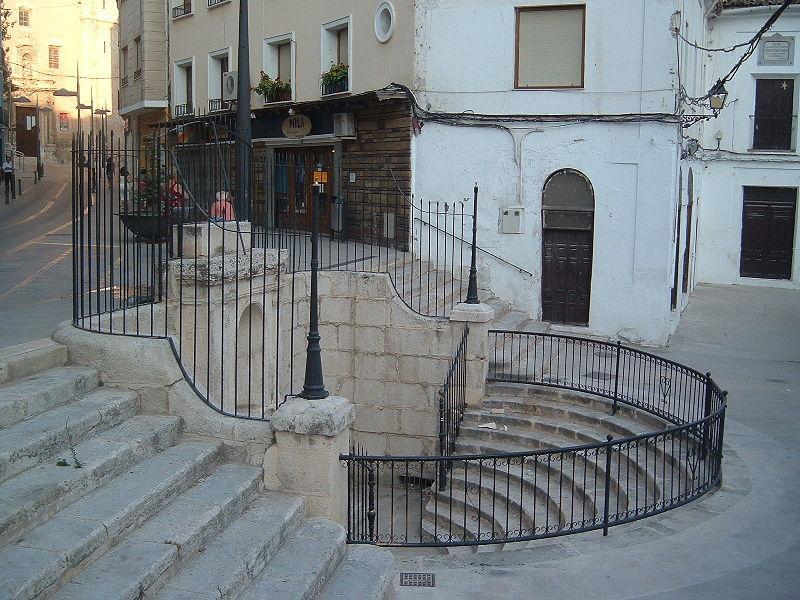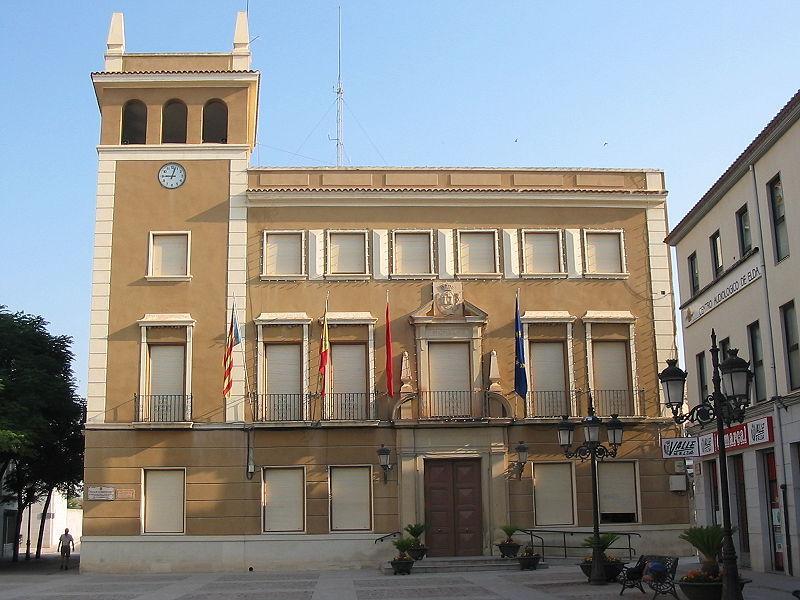Alicante, Comunidade Valenciana, Spain
Suggest Place to Visit
1487
Track to location with GPS |
 |
The first signs of human settlement in the area date back to the Neolithic and have been found in the El Chopo area. From later times, cave paintings have been found in the Gavilán ravine, the only ones in the Vinalopó, a burial in the Sierra de la Torreta, towns and sites from the Bronze Age in many areas of the term such as in the settlements of El Peñón del Trinitario, El Monastil and El Pont de la Jaud. The Phoenicians passed through the Altos de Camara and the Monastil. Also in Monastil, in the Bolón mountain range and the Chorrillo area, the Iberians left their mark, in what is known as the Iberian-Roman town of El Monastil.
The Romans began organized crops and trade and founded the nucleus of the current population. During Roman times, the period of maximum splendor of the city corresponds to the end of the 1st century and the beginning of the 2nd, with an intense commercial activity with Italy and the south of France. Around 590 AD a Visigoth episcopate was established, of which there are remains of a basilica in El Monastil.
When the Muslims arrived in the 8th century, the city of Elo became part of the Cora de Tudmir and its activity languished until it became a simple farmhouse. The Hispano-Visigothic population of the Elda Valley was scattered around the slopes of El Monastil and places near the river. It was from the year 1172 when the Muslims fortified the border of the Vinalopó and built the fortress around which a peasant community settled that constituted the true origin of the city of Elda. In the year 1243, through the Almizra treaty, it became part of the Crown of Castile. A year later Ferdinand III gave the castle and the town, now called Ella or Etlla, to Guillem, the German. In 1257 Alfonso X el Sabio gave it to his brother Manuel and the latter to his son Juan Manuel, Lord of Villena. This, in turn, gives it to his sister, Violante. In 1265 Jaime I recovered the town for Alfonso X, who had requested his help in the face of a Saracen uprising. In 1296 there was a war between Aragon and Castile, due to the promise by Alfonso de la Cerda to cede the Kingdom of Murcia to Jaime II in exchange for his support against the infant heir to the crown of Castile, Fernando IV. During this war, Jaime II conquered a large part of the Kingdom of Murcia, formed by the territories south of the Biar-Busot-Villajoyosa line, including Elda. In 1304 Fernando IV of Castile and Jaime II of Aragon signed the agreement of the Arbitral Sentence of Torrellas by which the military annexation of the ´´General Government of Orihuela´´ (current province of Alicante) was ratified, which left Elda included in the Kingdom of Valencia. In view of the friendship that united the Aragonese and the Rais of Crevillente, Muhammad ben Hudayr, the Muslims who remained were granted the privilege of speaking their language and practicing their worship.
During the 14th century the owner of the Elda valley was the Crown, until 1336 when Peter II the Ceremonious ceded the castle and the town to Beltran Duguesdin. In 1383 he returned to the monarchy. In 1424 Alfonso IV sold Elda to the Valencian nobleman Ximén Pérez de Corella, count of Cocentaina, whose descendants held the lordship until September 4, 1513, when, due to economic needs, they alienated the place in favor of the nobleman, of Jewish origin, Joan Coloma i Fernández, descendant of the old Catalan-Provençal nobility of the Folch de Cardona. The manorial title of Count of Elda - whose county included Petrel and Salinas - was granted by Felipe II, in 1577, to Joan Coloma i Cardona, son of the former. As part of the renewal process of the high nobility in the Kingdom of Valencia and to confer greater stability to its real estate heritage, Joan Coloma created the bond of mayorazgo for his son Antonio in 1581. The expulsion of the Moors forced 2,000 Moors into exile Eldenses, with which the town was inhabited with only 600 old Christians. Faced with this situation, the count granted a Puebla Charter with which he intended to repopulate his lands, but the harsh conditions that were imposed made the demographic recovery very slow. In 1698 the dam was replaced by a large swamp.
During the War of Succession Count Don Francisco Coloma supported Archduke Carlos (III), while most of the Eldense population opted for King Felipe V. After the war ended with the Bourbon triumph, the King granted the town the title of ´´Fidelísima´´ and punished the count with the confiscation of his property and possessions, although a few years later he was pardoned and his rights and privileges restored. After the death without direct descendants of the count, the title would pass to the Arias-Dávila family, then to the counts of Cervelló and, finally, to the Falcó, Dukes of Fernan-Núñez. Throughout the 18th and 19th centuries a period of prosperity was known in which the passage of the royal road from Madrid to Alicante and later the railway helped. In 1904 it obtained the title of city.
During the last period of the Spanish Civil War, in which the province of Alicante was one of the last strongholds to fall, Elda became the acting capital of the Second Spanish Republic, as the Government took refuge in Elda-Petrel for weeks before going into exile. The residence of President Negrín was located on the El Poblet de Petrel estate, while the Council of Ministers was held in the National Schools of Elda.
Elda is a city in the Valencian Community, Spain, located in the province of Alicante. It has a population of 55,168 inhabitants (2009), occupying the 7th place in number of inhabitants among the cities of the province of Alicante and its municipal term occupies an area of 44.86 square kilometers. Located on the banks of the Vinalopó River, it is the capital and most important city of the Medio Vinalopó region and forms, with Petrel, a conurbation of 89,691 inhabitants. It has an important footwear industry, particularly for women, which represents the main economic activity of the population.
Economy
The city of Elda was the engine of the industrial footwear activity in the valley. For a long time there had been a craft dedicated to the manufacture of esparto, a plant that was very abundant in the area. However, the activity was declining due to the disappearance of the plant, causing emigration.
In the mid-19th century, a new industry began to emerge dedicated to the manufacture of leather footwear. At first they were modest artisans who made the shoes and sold them at the village fairs. At the end of the 19th century a transformation began, appearing the first factories with machinery moved by animals. At the beginning of the 20th century, shoe production ranked third in provincial production, after textiles and wine.
The first quarter of the 20th century saw a strong development, but the 1940s saw a deep depression that forced a restructuring of the footwear industries. The industry was atomized and returned to its artisan beginnings. Many small artisan workshops appeared that acquired the different pieces of the shoe (heels, soles, etc.) in other workshops specialized only in that production and provided work at home, especially to women who, with a sewing machine at home , they solved the apparatus. This was the birth of what is now known as the underground economy, still in force and the pillar on which this industry has been based for many years.
The creation in 1960 of the FICIA (International Footwear and Related Industries Fair) was the final push. The big factories returned again and the manufacture and export of footwear was rationalized, which became a good source of profit. The construction of a large fairgrounds, the creation of CEPEX (Center for Export Promotion) and INESCOP (Spanish Institute of Footwear and Related Products) consolidated Elda as an important shoe capital.
The high degree of specialization of Elda's economy makes it very vulnerable due to variations in the sector. For example, the price of currencies, mainly the dollar, as the United States is one of the strongest buyers, significantly influences the development and evolution of this industry.
In recent years the sector has entered a crisis, partly due to Asian competition. Dependence on footwear is almost total, since most of the workers are employed in that industry or in auxiliary footwear products, although alternative industries are beginning to emerge in their industrial estates, with good communications to the highway.
Heritage
Shoe Museum
Located on the grounds of what was the International Footwear Fair, it was inaugurated on February 4, 1999 by Infanta Elena. Its importance lies in the fact that it collects and houses the entire history of footwear, with a large number of samples of both footwear and machinery dedicated to its production process, but also of the Auxiliary Industry, highlighting a wide section for the manufacture of footwear. last.
It is an old private chalet, built in 1925, which is located in the center of the city, surrounded by a garden. It was used as a blood hospital during the Civil War. The City Council acquired and restored it between 1985 and 1991. Various temporary exhibitions are held there, often of works by local artists.
Municipal Archaeological Museum.
It is located on the first floor of the House of Culture. It was created in 1983 with objects from the Archeology Section of the Eldense Excursionist Center and from amateur collections. Among its best pieces are the Siren of El Monastil, an important Iberian piece, and a magnificent fragment of the lid of an early Christian sarcophagus from the cycle of Jonah belonging to the 4th century together with other remains found in the Iberian-Roman town of Monastil and vestiges from the Neolithic period found in the archaeological site ´´Trinitario´´, on the slopes of Mount Bolón. You can find Iberian ceramics, with decorated vases, stamped Roman ceramics, sigillatas, skylights and terracotta.
It is located at the eastern end of Mount La Torreta. It sits on another from the Bronze Age (1800-1000 BC). The town is located on a rocky spur as an acropolis or citadel from which control of the nearby communication routes and farmland is exercised. The Councils of Toledo (7th century) reflect the existence of an episcopal see called Elotana, which has been identified with El Monastil by various historians.
Ethnological Museum
It is located next to the Shoe Museum. It contains the ethnological collection ´´Mosaico´´ with typical trades from the past and the municipal collection of ´´Pedrito Rico´´, a local singer.
Elda Castle
Elda Castle is a fortification located on a small hill next to the Vinalopó River, built between the 12th and 13th centuries. Between the 16th and 17th centuries it was transformed into the Condal Palace as the residence of the Coloma family. Although it is in a state of ruin, since 1983 reconstruction work has been carried out.
Church of Santa Ana.
The Church of Santa Ana is the oldest parish in Elda. It was founded in 1528 on the remains of an existing mosque, by order of Juan Francisco Pérez Calvillo Coloma (II Lord of Elda). With a square plan, with the passage of time it was expanded, adding chapels such as that of the Santísima Virgen de la Salud and that of the Santísimo Cristo del Buen Suceso. It has two bell towers of neoclassical influence.
Elda Swamp
The Elda reservoir is an irrigation dam dating from 1698, built on the Vinalopó riverbed. The surrounding area constitutes one of the largest reserves of tamarisks or tarays (Tamarix africana).
Main Square
The Plaza Mayor is located next to Plaza Sagasta, at the beginning of Calle Juan Carlos I and very close to the Church of Santa Ana. It was inaugurated in 1994 as the first Plaza Mayor in the Valencian Community. Various cultural activities take place here, such as chess competitions, book fairs and the Emplazarte fair, among others. In addition to numerous shops and restaurants, it houses the Plaza Cinemas, three movie theaters.
The Moors and Christians festivities of Elda are celebrated in honor of San Antón on the first weekend of June. At the origin of the festivities they were celebrated in mid-January, coinciding with the feast of the saint, but in 1946 it was decided to delay them for six months so that they would not be tarnished by the low temperatures. Thus in January the half party is celebrated, in which the winning squads parade in each comparsa.
There are four troupes on the Moorish side: the Cadí, Moroccan, Muslim and royalist hosts; and five on the Christian side: smugglers, Christians, students, pirates, and Gypsies.
Wednesday is the day of the PREGÓN, from this moment the festivities begin, usually the proclamation is given by a famous person.The proclamation begins around 10 in the Constitution Square, the people are not yet dressed in the festive costumes.
On Thursday at 8 o'clock in the afternoon the BANDS ENTRY begins, people are already dressed in festive costumes.In this act the troupes parade with a music group and the captaincy, to meet all the troupes in the Constitution Square and start singing the song ´´idella´´ here all the people who crowd the streets adjacent to the square, come together to sing. It is one of the acts that nobody misses. about 12 at night the RETRETA begins, a parade with the official costume and humorous character. Not all squads parade.
On Friday at 11:30 am Transfer of the image of San Antón to the church of Santa Ana. At 7 am the children's parade begins, here only children parade and no adults appear, except for those in charge of the comparsas. It is a very funny and entertaining parade.
On Saturday at 10 AM Alardo y Embajada, at 11:30 AM the Estafeta starts, it is an arquebusier battle and assault on the castle by Moorish troops. Triumphal parade of the Moorish ambassador and his entourage. At 6 AM the Christian Entrance begins, here All the troupes participate with adults and children included. The Christian ambassador and his entourage open the parade, followed by the pageantry of the corresponding troupe. The Christians begin and the Moors end.
On Sunday at 8 in the morning the DIANA and at 11 the OFFERING OF FLOWERS. At 6, ENTRANCE MORA just like the Christian opens the Moorish ambassador with her entourage followed by the Moorish pageantry and the Moorish side and finally the Christian.
On Monday at 10 AM Alardo and Embassy at 11:30 AM the Moorish Ambassador's assault on the castle and parade with his court. At 6:30 AM SOLEMN PROCESSION with a serious character, during the parade only the music of the band is heard , all the women carry a bouquet of flowers. closing the parade the parade that touches him leads the saint to the church. at the end a palm tree of fireworks is fired. immediately upon the arrival of the saint at his hermitage the ALBORADA is fired giving as over the holidays.
The Tickets get to exceed five hours of march and run through the streets of Eldenses. After them and until the early hours of the next day, dozens of music bands close and open each festive day without interruption.
The festeros meet in the so-called barracks. which are places distributed throughout the city where the comparsas and squads usually have lunch and dinners during the holidays.
Cultural events
The most important cultural events are the ´´Pintor Sorolla´´ painting prize, the ´´Ciudad de Elda´´ short story prize, the puppets and marionettes week and the ´´Elda de Estreno´´ film week. The last Sunday of each month the Emplazarte art fair takes place, which takes place in the Plaza Mayor and brings together artists and fans of the world of Plastic Arts.
In addition, since 1999, the Elda Footwear Museum has annually awarded an award to the ´´Woman with the best road in Spain´´. The awarding of this award means that four local shoe companies wear the winner for an entire season. Since its creation, the winners have been Ana Rosa Quintana (1999), Concha Velasco (2000), Anne Igartiburu (2001), Carmen Cervera (2002), Terelu Campos (2003), Paz Vega (2004), Marta Sánchez (2005) and Nuria Roca (2006).
Elda is part of the cultural route called Camino del Cid, in the Villena-Elda and Elda-Elch stages
Comments
We don´t have yet any comments about:
Elda
Elda
Be the first to leave a comment as it is very important to inform other people
Outros locais a visitar
Within a radius of 20 km from:Elda
Sax Castle |
| 6,9 Km |
 |
Castle Atalaya |
| 17,5 Km |
 |
Villena |
| 18,1 Km |
 |
Hotel reservation near Elda within a radius of 20 km
Why to book with
The best prices
Our partnerships with the world´s largest operators offer research on the best market prices.
More options
At Rotas Turisticos you can book the hotel, buy the air ticket, book the transfer from the airport to the hotel and vice versa, book the local excursions, rent the car, take travel insurance and consult the places to visit and where to go.
Holiday Tips & Destinations
Hundreds of holiday destinations with all the options that allow you to easily choose the destination that best suits your dream vacation.
Links






